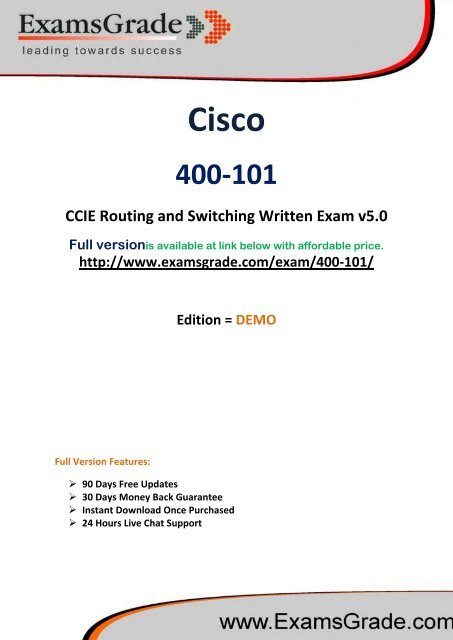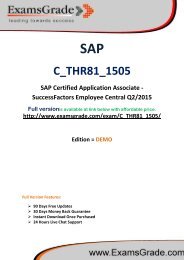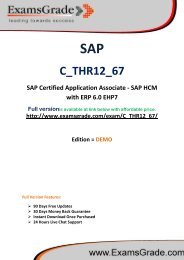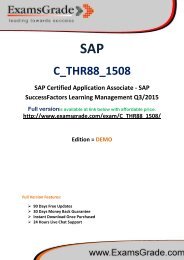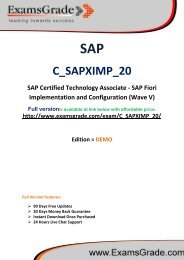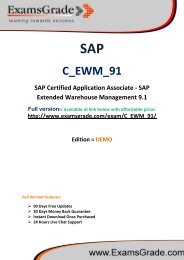ExamsGrade 400-101 Exam Passing Guaranteed Tips
Get high success rate in 400-101 Certification Exam with our exam PDF questions answers prepared by the authorized persons of Information Technology industry. For more info please visit here: http://www.examsgrade.com/exam/400-101/
Get high success rate in 400-101 Certification Exam with our exam PDF questions answers prepared by the authorized persons of Information Technology industry. For more info please visit here: http://www.examsgrade.com/exam/400-101/
Create successful ePaper yourself
Turn your PDF publications into a flip-book with our unique Google optimized e-Paper software.
Cisco<br />
<strong>400</strong>-<strong>101</strong><br />
CCIE Routing and Switching Written <strong>Exam</strong> v5.0<br />
Full versionis available at link below with affordable price.<br />
http://www.examsgrade.com/exam/<strong>400</strong>-<strong>101</strong>/<br />
Edition = DEMO<br />
Full Version Features:<br />
‣ 90 Days Free Updates<br />
‣ 30 Days Money Back Guarantee<br />
‣ Instant Download Once Purchased<br />
‣ 24 Hours Live Chat Support
Question: 1<br />
Which two options are causes of out-of-order packets? (Choose two.)<br />
A. a routing loop<br />
B. a router in the packet flow path that is intermittently dropping packets<br />
C. high latency<br />
D. packets in a flow traversing multiple paths through the network<br />
E. some packets in a flow being process-switched and others being interrupt-switched on a transit<br />
router<br />
Answer: D,E<br />
Explanation:<br />
In traditional packet forwarding systems, using different paths have varying latencies that cause out<br />
of order packets, eventually resulting in far lower performance for the network application. Also, if<br />
some packets are process switched quickly by the routing engine of the router while others are<br />
interrupt switched (which takes more time) then it could result in out of order packets. The other<br />
options would cause packet drops or latency, but not out of order packets.<br />
Question: 2<br />
A TCP/IP host is able to transmit small amounts of data (typically less than 1500 bytes), but attempts<br />
to transmit larger amounts of data hang and then time out. What is the cause of this problem?<br />
A. A link is flapping between two intermediate devices.<br />
B. The processor of an intermediate router is averaging 90 percent utilization.<br />
C. A port on the switch that is connected to the TCP/IP host is duplicating traffic and sending it to a<br />
port that has a sniffer attached.<br />
D. There is a PMTUD failure in the network path.<br />
Answer: D<br />
Explanation:<br />
Sometimes, over some IP paths, a TCP/IP node can send small amounts of data (typically less than<br />
1500 bytes) with no difficulty, but transmission attempts with larger amounts of data hang, then<br />
time out. Often this is observed as a unidirectional problem in that large data transfers succeed in<br />
one direction but fail in the other direction. This problem is likely caused by the TCP MSS value,<br />
PMTUD failure, different LAN media types, or defective links.<br />
References:<br />
Question: 3<br />
http://www.examsgrade.com/exam/<strong>400</strong>-<strong>101</strong>/<br />
pg. 2
Refer to the exhibit.<br />
ICMP Echo requests from host A are not reaching the intended destination on host B. What is the<br />
problem?<br />
A. The ICMP payload is malformed.<br />
B. The ICMP Identifier (BE) is invalid.<br />
C. The negotiation of the connection failed.<br />
D. The packet is dropped at the next hop.<br />
E. The link is congested.<br />
Answer: D<br />
Explanation:<br />
Here we see that the Time to Live (TTL) value of the packet is one, so it will be forwarded to the next<br />
hop router, but then dropped because the TTL value will be 0 at the next hop.<br />
Question: 4<br />
Refer to the exhibit.<br />
Which statement is true?<br />
A. It is impossible for the destination interface to equal the source interface.<br />
B. NAT on a stick is performed on interface Et0/0.<br />
C. There is a potential routing loop.<br />
D. This output represents a UDP flow or a TCP flow.<br />
http://www.examsgrade.com/exam/<strong>400</strong>-<strong>101</strong>/<br />
pg. 3
Answer: C<br />
Explanation:<br />
In this example we see that the source interface and destination interface are the same (Et0/0).<br />
Typically this is seen when there is a routing loop for the destination IP address.<br />
Question: 5<br />
Which three conditions can cause excessive unicast flooding? (Choose three.)<br />
A. Asymmetric routing<br />
B. Repeated TCNs<br />
C. The use of HSRP<br />
D. Frames sent to FFFF.FFFF.FFFF<br />
E. MAC forwarding table overflow<br />
F. The use of Unicast Reverse Path Forwarding<br />
Answer: A,B,E<br />
Explanation:<br />
Causes of Flooding<br />
The very cause of flooding is that destination MAC address of the packet is not in the L2 forwarding<br />
table of the switch. In this case the packet will be flooded out of all forwarding ports in its VLAN<br />
(except the port it was received on). Below case studies display most common reasons for<br />
destination MAC address not being known to the switch.<br />
Cause 1: Asymmetric Routing<br />
Large amounts of flooded traffic might saturate low-bandwidth links causing network performance<br />
issues or complete connectivity outage to devices connected across such low-bandwidth links.<br />
Cause 2: Spanning-Tree Protocol Topology Changes<br />
Another common issue caused by flooding is Spanning-Tree Protocol (STP) Topology Change<br />
Notification (TCN). TCN is designed to correct forwarding tables after the forwarding topology has<br />
changed. This is necessary to avoid a connectivity outage, as after a topology change some<br />
destinations previously accessible via particular ports might become accessible via different ports.<br />
TCN operates by shortening the forwarding table aging time, such that if the address is not<br />
relearned, it will age out and flooding will occur.<br />
TCNs are triggered by a port that is transitioning to or from the forwarding state. After the TCN, even<br />
if the particular destination MAC address has aged out, flooding should not happen for long in most<br />
cases since the address will be relearned. The issue might arise when TCNs are occurring repeatedly<br />
with short intervals. The switches will constantly be fast-aging their forwarding tables so flooding will<br />
be nearly constant.<br />
Normally, a TCN is rare in a well-configured network. When the port on a switch goes up or down,<br />
there is eventually a TCN once the STP state of the port is changing to or from forwarding. When the<br />
port is flapping, repetitive TCNs and flooding occurs.<br />
Cause 3: Forwarding Table Overflow<br />
Another possible cause of flooding can be overflow of the switch forwarding table. In this case, new<br />
addresses cannot be learned and packets destined to such addresses are flooded until some space<br />
http://www.examsgrade.com/exam/<strong>400</strong>-<strong>101</strong>/<br />
pg. 4
ecomes available in the forwarding table. New addresses will then be learned. This is possible but<br />
rare, since most modern switches have large enough forwarding tables to accommodate MAC<br />
addresses for most designs.<br />
Forwarding table exhaustion can also be caused by an attack on the network where one host starts<br />
generating frames each sourced with different MAC address. This will tie up all the forwarding table<br />
resources. Once the forwarding tables become saturated, other traffic will be flooded because new<br />
learning cannot occur. This kind of attack can be detected by examining the switch forwarding table.<br />
Most of the MAC addresses will point to the same port or group of ports. Such attacks can be<br />
prevented by limiting the number of MAC addresses learned on untrusted ports by using the port<br />
security feature.<br />
References:<br />
Question: 6<br />
Which congestion-avoidance or congestion-management technique can cause global<br />
synchronization?<br />
A. Tail drop<br />
B. Random early detection<br />
C. Weighted random early detection<br />
D. Weighted fair queuing<br />
Answer: A<br />
Explanation:<br />
Tail Drop<br />
Tail drop treats all traffic equally and does not differentiate between classes of service. Queues fill<br />
during periods of congestion. When the output queue is full and tail drop is in effect, packets are<br />
dropped until the congestion is eliminated and the queue is no longer full.<br />
Weighted Random Early Detection<br />
WRED avoids the globalization problems that occur when tail drop is used as the congestion<br />
avoidance mechanism on the router. Global synchronization occurs as waves of congestion crest<br />
only to be followed by troughs during which the transmission link is not fully utilized. Global<br />
synchronization of TCP hosts, for example, can occur because packets are dropped all at once. Global<br />
synchronization manifests when multiple TCP hosts reduce their transmission rates in response to<br />
packet dropping, then increase their transmission rates once again when the congestion is reduced.<br />
References:<br />
Question: 7<br />
Which two options are reasons for TCP starvation? (Choose two.)<br />
A. The use of tail drop<br />
B. The use of WRED<br />
C. Mixing TCP and UDP traffic in the same traffic class<br />
D. The use of TCP congestion control<br />
http://www.examsgrade.com/exam/<strong>400</strong>-<strong>101</strong>/<br />
pg. 5
Answer: C,D<br />
Explanation:<br />
It is a general best practice to not mix TCP-based traffic with UDP-based traffic (especially Streaming-<br />
Video) within a single service-provider class because of the behaviors of these protocols during<br />
periods of congestion. Specifically, TCP transmitters throttle back flows when drops are detected.<br />
Although some UDP applications have application-level windowing, flow control, and retransmission<br />
capabilities, most UDP transmitters are completely oblivious to drops and, thus, never lower<br />
transmission rates because of dropping.<br />
When TCP flows are combined with UDP flows within a single service-provider class and the class<br />
experiences congestion, TCP flows continually lower their transmission rates, potentially giving up<br />
their bandwidth to UDP flows that are oblivious to drops. This effect is called TCP starvation/UDP<br />
dominance.<br />
TCP starvation/UDP dominance likely occurs if (TCP-based) Mission-Critical Data is assigned to the<br />
same service-provider class as (UDP-based) Streaming-Video and the class experiences sustained<br />
congestion. Even if WRED or other TCP congestion control mechanisms are enabled on the serviceprovider<br />
class, the same behavior would be observed because WRED (for the most part) manages<br />
congestion only on TCP-based flows.<br />
References:<br />
Question: 8<br />
Refer to the exhibit.<br />
While troubleshooting high CPU utilization of a Cisco Catalyst 4500 Series Switch, you notice the<br />
error message that is shown in the exhibit in the log file.<br />
What can be the cause of this issue, and how can it be prevented?<br />
A. The hardware routing table is full. Redistribute from BGP into IGP.<br />
B. The software routing table is full. Redistribute from BGP into IGP.<br />
C. The hardware routing table is full. Reduce the number of routes in the routing table.<br />
D. The software routing table is full. Reduce the number of routes in the routing table.<br />
Answer: C<br />
Explanation:<br />
L3HWFORWADING-2<br />
Error MessageC4K_L3HWFORWARDING-2-FWDCAMFULL:L3 routing table is full. Switching to<br />
software forwarding.<br />
The hardware routing table is full; forwarding takes place in the software instead. The switch<br />
performance might be degraded.<br />
Recommended Action: Reduce the size of the routing table. Enter the ip cef command to return to<br />
hardware forwarding.<br />
References:<br />
Question: 9<br />
http://www.examsgrade.com/exam/<strong>400</strong>-<strong>101</strong>/<br />
pg. 6
Refer to the exhibit.<br />
Which two are causes of output queue drops on FastEthernet0/0? (Choose two.)<br />
A. an oversubscribed input service policy on FastEthernet0/0<br />
B. a duplex mismatch on FastEthernet0/0<br />
C. a bad cable connected to FastEthernet0/0<br />
D. an oversubscribed output service policy on FastEthernet0/0<br />
E. The router trying to send more than 100 Mb/s out of FastEthernet0/0<br />
Answer: D,E<br />
Explanation:<br />
Output drops are caused by a congested interface. For example, the traffic rate on the outgoing<br />
interface cannot accept all packets that should be sent out, or a service policy is applied that is<br />
oversubscribed. The ultimate solution to resolve the problem is to increase the line speed. However,<br />
there are ways to prevent, decrease, or control output drops when you do not want to increase the<br />
line speed. You can prevent output drops only if output drops are a consequence of short bursts of<br />
data. If output drops are caused by a constant high-rate flow, you cannot prevent the drops.<br />
However, you can control them.<br />
References:<br />
http://www.examsgrade.com/exam/<strong>400</strong>-<strong>101</strong>/<br />
pg. 7
Question: 10<br />
Refer to the exhibit.<br />
Which statement about the output is true?<br />
A. The flow is an HTTPS connection to the router, which is initiated by 144.254.10.206.<br />
B. The flow is an HTTP connection to the router, which is initiated by 144.254.10.206.<br />
C. The flow is an HTTPS connection that is initiated by the router and that goes to 144.254.10.206.<br />
D. The flow is an HTTP connection that is initiated by the router and that goes to 144.254.10.206.<br />
Answer: A<br />
Explanation:<br />
We can see that the connection is initiated by the Source IP address shown as 144.254.10.206. We<br />
also see that the destination protocol (DstP) shows 01BB, which is in hex and translates to 443 in<br />
decimal. SSL/HTTPS uses port 443.<br />
Question: 11<br />
What is the cause of ignores and overruns on an interface, when the overall traffic rate of the<br />
interface is low?<br />
A. a hardware failure of the interface<br />
B. a software bug<br />
C. a bad cable<br />
D. microbursts of traffic<br />
Answer: D<br />
Explanation:<br />
Micro-bursting is a phenomenon where rapid bursts of data packets are sent in quick succession,<br />
leading to periods of full line-rate transmission that can overflow packet buffers of the network<br />
stack, both in network endpoints and routers and switches inside the network.<br />
Symptoms of micro bursts will manifest in the form of ignores and/ or overruns (also shown as<br />
accumulated in “input error” counter within show interface output). This is indicative of receive ring<br />
and corresponding packet buffer being overwhelmed due to data bursts coming in over extremely<br />
short period of time (microseconds). You will never see a sustained data traffic within show<br />
interface’s “input rate” counter as they are averaging bits per second (bps) over 5 minutes by default<br />
(way too long to account for microbursts). You can understand microbursts from a scenario where a<br />
http://www.examsgrade.com/exam/<strong>400</strong>-<strong>101</strong>/<br />
pg. 8
3-lane highway merging into a single lane at rush hour – the capacity burst cannot exceed the total<br />
available bandwidth (i.e. single lane), but it can saturate it for a period of time.<br />
References:<br />
Question: 12<br />
Refer to the exhibit.<br />
Which statement about the debug behavior of the device is true?<br />
A. The device debugs all IP events for 172.16.129.4.<br />
B. The device sends all debugging information for 172.16.129.4.<br />
C. The device sends only NTP debugging information to 172.16.129.4.<br />
D. The device sends debugging information every five seconds.<br />
Answer: A<br />
Explanation:<br />
This is an example of a conditional debug, where there is a single condition specified of IP address<br />
172.16.129.4. So, all IP events for that address will be output in the debug.<br />
Question: 13<br />
Which statement about MSS is true?<br />
A. It is negotiated between sender and receiver.<br />
B. It is sent in all TCP packets.<br />
C. It is 20 bytes lower than MTU by default.<br />
D. It is sent in SYN packets.<br />
E. It is 28 bytes lower than MTU by default.<br />
Answer: D<br />
Explanation:<br />
The maximum segment size (MSS) is a parameter of the Options field of the TCP header that<br />
specifies the largest amount of data, specified in octets, that a computer or communications device<br />
can receive in a single TCP segment. It does not count the TCP header or the IP header. The IP<br />
datagram containing a TCP segment may be self-contained within a single packet, or it may be<br />
http://www.examsgrade.com/exam/<strong>400</strong>-<strong>101</strong>/<br />
pg. 9
econstructed from several fragmented pieces; either way, the MSS limit applies to the total amount<br />
of data contained in the final, reconstructed TCP segment.<br />
The default TCP Maximum Segment Size is 536. Where a host wishes to set the maximum segment<br />
size to a value other than the default, the maximum segment size is specified as a TCP option,<br />
initially in the TCP SYN packet during the TCP handshake. The value cannot be changed after the<br />
connection is established.<br />
References:<br />
Question: 14<br />
Which two methods change the IP MTU value for an interface? (Choose two.)<br />
A. Configure the default MTU.<br />
B. Configure the IP system MTU.<br />
C. Configure the interface MTU.<br />
D. Configure the interface IP MTU.<br />
Answer: C,D<br />
Explanation:<br />
An IOS device configured for IP+MPLS routing uses three different Maximum Transmission Unit<br />
(MTU) values: The hardware MTU configured with the mtu interface configuration command<br />
The hardware MTU specifies the maximum packet length the interface can support … or at least<br />
that's the theory behind it. In reality, longer packets can be sent (assuming the hardware interface<br />
chipset doesn't complain); therefore you can configure MPLS MTU to be larger than the interface<br />
MTU and still have a working network. Oversized packets might not be received correctly if the<br />
interface uses fixed-length buffers; platforms with scatter/gather architecture (also called particle<br />
buffers) usually survive incoming oversized packets.<br />
IP MTU is used to determine whether am IP packet forwarded through an interface has to be<br />
fragmented. It has to be lower or equal to hardware MTU (and this limitation is enforced). If it equals<br />
the HW MTU, its value does not appear in the running configuration and it tracks the changes in HW<br />
MTU. For example, if you configure ip mtu 1300 on a Serial interface, it will appear in the running<br />
configuration as long as the hardware MTU is not equal to 1300 (and will not change as the HW MTU<br />
changes). However, as soon as the mtu 1300 is configured, the ip mtu 1300 command disappears<br />
from the configuration and the IP MTU yet again tracks the HW MTU.<br />
References:<br />
Question: 15<br />
Which implementation can cause packet loss when the network includes asymmetric routing paths?<br />
A. the use of ECMP routing<br />
B. the use of penultimate hop popping<br />
C. the use of Unicast RPF<br />
D. disabling Cisco Express Forwarding<br />
http://www.examsgrade.com/exam/<strong>400</strong>-<strong>101</strong>/<br />
pg. 10
Answer: C<br />
Explanation:<br />
When administrators use Unicast RPF in strict mode, the packet must be received on the interface<br />
that the router would use to forward the return packet. Unicast RPF configured in strict mode may<br />
drop legitimate traffic that is received on an interface that was not the router's choice for sending<br />
return traffic. Dropping this legitimate traffic could occur when asymmetric routing paths are<br />
present in the network.<br />
References:<br />
Question: 16<br />
Which two mechanisms can be used to eliminate Cisco Express Forwarding polarization? (Choose<br />
two.)<br />
A. alternating cost links<br />
B. the unique-ID/universal-ID algorithm<br />
C. Cisco Express Forwarding antipolarization<br />
D. different hashing inputs at each layer of the network<br />
Answer: B,D<br />
Explanation:<br />
This document describes how Cisco Express Forwarding (CEF) polarization can cause suboptimal use<br />
of redundant paths to a destination network. CEF polarization is the effect when a hash algorithm<br />
chooses a particular path and the redundant paths remain completely unused.<br />
How to Avoid CEF Polarization<br />
The hash algorithm load-balances this way by default:<br />
1: 1<br />
2: 7-8<br />
3: 1-1-1<br />
4: 1-1-1-2<br />
5: 1-1-1-1-1<br />
6: 1-2-2-2-2-2<br />
7: 1-1-1-1-1-1-1<br />
8: 1-1-1-2-2-2-2-2<br />
The number before the colon represents the number of equal-cost paths. The number after the<br />
colon represents the proportion of traffic which is forwarded per path.<br />
This means that:<br />
This illustrates that, when there is even number of ECMP links, the traffic is not load-balanced.<br />
References:<br />
Question: 17<br />
Which two mechanisms provide Cisco IOS XE Software with control plane and data plane<br />
separation? (Choose two.)<br />
http://www.examsgrade.com/exam/<strong>400</strong>-<strong>101</strong>/<br />
pg. 11
A. Forwarding and Feature Manager<br />
B. Forwarding Engine Driver<br />
C. Forwarding Performance Management<br />
D. Forwarding Information Base<br />
Answer: A,B<br />
Explanation:<br />
Control Plane and Data Plane Separation<br />
IOS XE introduces an opportunity to enable teams to now build drivers for new Data Plane ASICs<br />
outside the IOS instance and have them program to a set of standard APIs which in turn enforces<br />
Control Plane and Data Plane processing separation.<br />
IOS XE accomplishes Control Plane / Data Plane separation through the introduction of the<br />
Forwarding and Feature Manager (FFM) and its standard interface to the Forwarding Engine Driver<br />
(FED). FFM provides a set of APIs to Control Plane processes. In turn, the FFM programs the Data<br />
Plane via the FED and maintains forwarding state for the system. The FED is the instantiation of the<br />
hardware driver for the Data Plane and is provided by the platform.<br />
References:<br />
Question: 18<br />
Refer to the exhibit.<br />
What is the PHB class on this flow?<br />
A. EF<br />
B. none<br />
C. AF21<br />
D. CS4<br />
Answer: D<br />
Explanation:<br />
This command shows the TOS value in hex, which is 80 in this case. The following chart shows some<br />
common DSCP/PHB Class values:<br />
Service<br />
DSCP value<br />
TOS value<br />
Juniper Alias<br />
TOS hexadecimal<br />
DSCP - TOS Binary<br />
http://www.examsgrade.com/exam/<strong>400</strong>-<strong>101</strong>/<br />
pg. 12
Premium IP<br />
46<br />
184<br />
ef<br />
B8<br />
<strong>101</strong>110 - <strong>101</strong>110xx<br />
LBE<br />
8<br />
32<br />
cs1<br />
20<br />
001000 - 001000xx<br />
DWS<br />
32<br />
128<br />
cs4<br />
80<br />
100000 - 100000xx<br />
Network control<br />
48<br />
192<br />
cs6<br />
c0<br />
110000 - 110000xx<br />
Network control 2<br />
56<br />
224<br />
cs7<br />
e0<br />
111000 - 111000xx<br />
References:<br />
Question: 19<br />
Refer to the exhibit.<br />
What kind of load balancing is done on this router?<br />
A. per-packet load balancing<br />
B. per-flow load balancing<br />
C. per-label load balancing<br />
D. star round-robin load balancing<br />
http://www.examsgrade.com/exam/<strong>400</strong>-<strong>101</strong>/<br />
pg. 13<br />
Answer: A
Explanation:<br />
Here we can see that for the same traffic source/destination pair of 10.0.0.1 to 14.0.0.2 there were a<br />
total of 100 packets (shown by second entry without the *) and that the packets were distributed<br />
evenly across the three different outgoing interfaces (34, 33, 33 packets, respectively.<br />
Question: 20<br />
What is the most efficient way to confirm whether microbursts of traffic are occurring?<br />
A. Monitor the output traffic rate using the show interface command.<br />
B. Monitor the output traffic rate using the show controllers command.<br />
C. Check the CPU utilization of the router.<br />
D. Sniff the traffic and plot the packet rate over time.<br />
Answer: D<br />
Explanation:<br />
Micro-bursting is a phenomenon where rapid bursts of data packets are sent in quick succession,<br />
leading to periods of full line-rate transmission that can overflow packet buffers of the network<br />
stack, both in network endpoints and routers and switches inside the network.<br />
In order to troubleshoot microbursts, you need a packet sniffer that can capture traffic over a long<br />
period of time and allow you to analyze it in the form of a graph which displays the saturation points<br />
(packet rate during microbursts versus total available bandwidth). You can eventually trace it to the<br />
source causing the bursts (e.g. stock trading applications).<br />
References:<br />
Question: 21<br />
What is a cause for unicast flooding?<br />
A. Unicast flooding occurs when multicast traffic arrives on a Layer 2 switch that has directly<br />
connected multicast receivers.<br />
B. When PIM snooping is not enabled, unicast flooding occurs on the switch that interconnects the<br />
PIM-enabled routers.<br />
C. A man-in-the-middle attack can cause the ARP cache of an end host to have the wrong MAC<br />
address. Instead of having the MAC address of the default gateway, it has a MAC address of the<br />
man-in-the-middle. This causes all traffic to be unicast flooded through the man-in-the-middle,<br />
which can then sniff all packets.<br />
D. Forwarding table overflow prevents new MAC addresses from being learned, and packets<br />
destined to those MAC addresses are flooded until space becomes available in the forwarding table.<br />
Answer: D<br />
http://www.examsgrade.com/exam/<strong>400</strong>-<strong>101</strong>/<br />
pg. 14
Explanation:<br />
Causes of Flooding<br />
The very cause of flooding is that destination MAC address of the packet is not in the L2 forwarding<br />
table of the switch. In this case the packet will be flooded out of all forwarding ports in its VLAN<br />
(except the port it was received on). Below case studies display most common reasons for<br />
destination MAC address not being known to the switch.<br />
Cause 1: Asymmetric Routing<br />
Large amounts of flooded traffic might saturate low-bandwidth links causing network performance<br />
issues or complete connectivity outage to devices connected across such low-bandwidth links<br />
Cause 2: Spanning-Tree Protocol Topology Changes<br />
Another common issue caused by flooding is Spanning-Tree Protocol (STP) Topology Change<br />
Notification (TCN). TCN is designed to correct forwarding tables after the forwarding topology has<br />
changed. This is necessary to avoid a connectivity outage, as after a topology change some<br />
destinations previously accessible via particular ports might become accessible via different ports.<br />
TCN operates by shortening the forwarding table aging time, such that if the address is not<br />
relearned, it will age out and flooding will occur<br />
Cause 3: Forwarding Table Overflow<br />
Another possible cause of flooding can be overflow of the switch forwarding table. In this case, new<br />
addresses cannot be learned and packets destined to such addresses are flooded until some space<br />
becomes available in the forwarding table. New addresses will then be learned. This is possible but<br />
rare, since most modern switches have large enough forwarding tables to accommodate MAC<br />
addresses for most designs.<br />
References:<br />
Question: 22<br />
Refer to the exhibit.<br />
http://www.examsgrade.com/exam/<strong>400</strong>-<strong>101</strong>/<br />
pg. 15
Video Source S is sending interactive video traffic to Video Receiver R. Router R1 has multiple<br />
routing table entries for destination R. Which load-balancing mechanism on R1 can cause out-oforder<br />
video traffic to be received by destination R?<br />
A. per-flow load balancing on R1 for destination R<br />
B. per-source-destination pair load balancing on R1 for destination R<br />
C. CEF load balancing on R1 for destination R<br />
D. per-packet load balancing on R1 for destination R<br />
Answer: D<br />
Explanation:<br />
Per-packet load balancing guarantees equal load across all links, however potentially the packets<br />
may arrive out-of-order at the destination as differential delay may exist within the network.<br />
References:<br />
Question: 23<br />
What is Nagle's algorithm used for?<br />
A. To increase the latency<br />
B. To calculate the best path in distance vector routing protocols<br />
C. To calculate the best path in link state routing protocols<br />
D. To resolve issues caused by poorly implemented TCP flow control.<br />
Answer: D<br />
Explanation:<br />
Silly window syndrome is a problem in computer networking caused by poorly implemented TCP<br />
flow control. A serious problem can arise in the sliding window operation when the sending<br />
application program creates data slowly, the receiving application program consumes data slowly, or<br />
both. If a server with this problem is unable to process all incoming data, it requests that its clients<br />
reduce the amount of data they send at a time (the window setting on a TCP packet). If the server<br />
continues to be unable to process all incoming data, the window becomes smaller and smaller,<br />
sometimes to the point that the data transmitted is smaller than the packet header, making data<br />
transmission extremely inefficient. The name of this problem is due to the window size shrinking to a<br />
"silly" value. When there is no synchronization between the sender and receiver regarding capacity<br />
of the flow of data or the size of the packet, the window syndrome problem is created. When the<br />
silly window syndrome is created by the sender, Nagle's algorithm is used. Nagle's solution requires<br />
that the sender sends the first segment even if it is a small one, then that it waits until an ACK is<br />
received or a maximum sized segment (MSS) is accumulated.<br />
References:<br />
Question: 24<br />
http://www.examsgrade.com/exam/<strong>400</strong>-<strong>101</strong>/<br />
pg. 16
Which statement is true regarding the UDP checksum?<br />
A. It is used for congestion control.<br />
B. It cannot be all zeros.<br />
C. It is used by some Internet worms to hide their propagation.<br />
D. It is computed based on the IP pseudo-header.<br />
Answer: D<br />
Explanation:<br />
The method used to compute the checksum is defined in RFC 768:<br />
“Checksum is the 16-bit one's complement of the one's complement sum of a pseudo header of<br />
information from the IP header, the UDP header, and the data, padded with zero octets at the end<br />
(if necessary) to make a multiple of two octets.”<br />
In other words, all 16-bit words are summed using one's complement arithmetic. Add the 16-bit<br />
values up. Each time a carry-out (17th bit) is produced, swing that bit around and add it back into the<br />
least significant bit. The sum is then one's complemented to yield the value of the UDP checksum<br />
field.<br />
If the checksum calculation results in the value zero (all 16 bits 0) it should be sent as the one's<br />
complement (all 1s).<br />
References:<br />
Question: 25<br />
Which statement describes the purpose of the Payload Type field in the RTP header?<br />
A. It identifies the signaling protocol.<br />
B. It identifies the codec.<br />
C. It identifies the port numbers for RTP.<br />
D. It identifies the port numbers for RTCP.<br />
Answer: B<br />
Explanation:<br />
PT, Payload Type. 7 bits: Identifies the format of the RTP payload and determines its interpretation<br />
by the application. A profile specifies a default static mapping of payload type codes to payload<br />
formats. Additional payload type codes may be defined dynamically through non-RTP means. An RTP<br />
sender emits a single RTP payload type at any given time; this field is not intended for multiplexing<br />
separate media streams. A full list of codecs and their payload type values can be found at the link<br />
below:<br />
References:<br />
http://www.examsgrade.com/exam/<strong>400</strong>-<strong>101</strong>/<br />
pg. 17
For More Information:<br />
http://www.examsgrade.com/exam/<strong>400</strong>-<strong>101</strong>/<br />
http://www.examsgrade.com/exam/<strong>400</strong>-<strong>101</strong>/<br />
pg. 18


